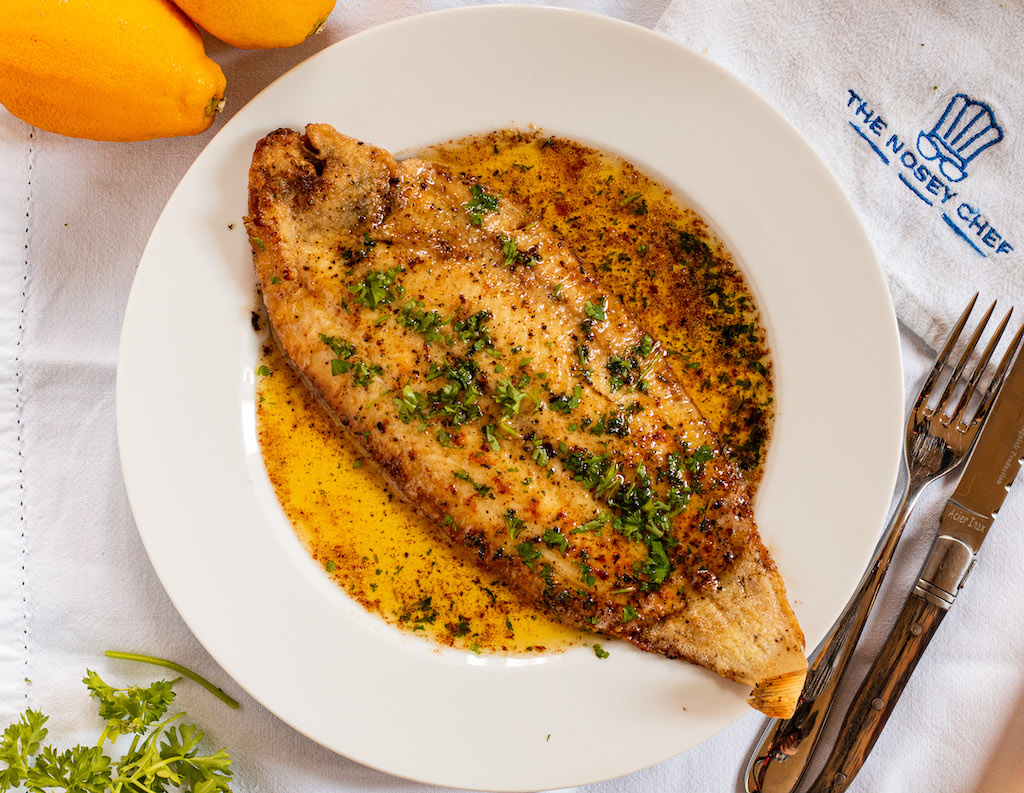Solea solea, while a beautiful thing to eat, is one ugly mother of a fish. The evolution of flat fish like sole is one of those damn-near intractable biological puzzles that defy logic, and give ammunition to religiously motivated creationists and scientologists. One day, a normal, upright fish decided to lie down on the sea floor and never get up again. Having one eye in the sand was never going to be great for the binocular vision needed to locate food and avoid predators; so, over many genetic passages, this reclining fish family gradually moved their pectoral eye upwards until it ended up on the other side of their heads to find company with the dorsal eye. The mouth stayed where it was, resulting in a series of creatures with both eyes on the same side of their heads. Lovely to eat, but I wouldn’t date one.
The French have always enjoyed their national sport of taking the piss out of British food. However, there are a few of key areas where even the most shruggy Gallic gourmand would be prepared to tip their chapeau to the English. One of these is Stilton cheese. Another is the Dover sole. Solea solea are fished in the English Channel, Atlantic, Baltic and North Sea, and landed primarily in Britain (including Scotland), The Netherlands, Belgium and Denmark. Of all the flat fish, Dover sole is the most prized, due to its delicate flavour and firm flesh that holds together as it is cooked. Prices reflect their culinary value with one fish setting you back about £11. If Dover sole appears on a restaurant menus, it is invariably the most expensive thing on it.
For sole meunière, the term is derived from ‘miller’s wife,’ in recognition of the flour, which is one of the handful of ingredients in the recipe. Said to be a favourite of Franc’s ‘Sun King ‘King Louis XIV, this dish is probably incredibly old and is likely to date back to the invention of butter and the milling of wheat. I am thinking Roman. The recipe given here is from Paul Bocuse.

Sole meunière
Ingredients
- For the fish:
- 1 Dover sole, de-finned and skinned on both sides
- Sea salt and freshly ground black pepper
- 4 tbsp plain flour
- 100g unsalted butter (see notes)
- For the sauce:
- 100g unsalted butter
- Juice of half a lemon
- 1 tbsp parsley, finely chopped
Instructions
To cook the fish:
Season the fish and dredge in the flour until coated. Shake off the excess.
Heat the butter in a frying pan on high and fry the thin side of the sole (the side that had the white skin) for 4–5 mins until browned.
Turn the heat down.
Flip the fish over and tilt the pan so that the butter pools near the rim. Use a spoon to baste the fish with the butter for about 3 mins until the other side is just done. Remove the fish to a plate while you do the sauce.
To make the sauce and serve:
Pour the cooking fat out of the pan and discard.
Heat 100g butter in the fry pan until foaming. Add the lemon juice and boil for a moment, Whisk together and add the parsley. Pour over the fish. Sprinkle a little more parsley over the whole gig.
Notes
Care is needed in cooking the fish as the butter may burn and put bitter, black bits in your sauce. A little of this is OK, but if you want to avoid this entirely, use clarified butter. This dish is classically served with butted and herbed new potatoes.






No Comments